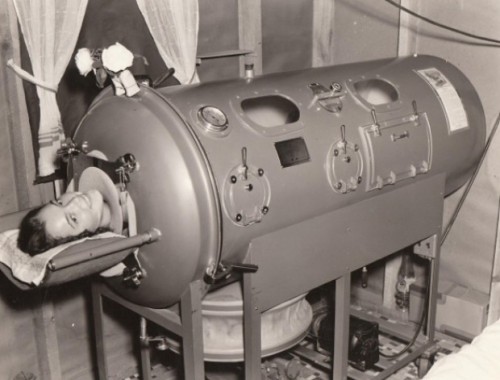Polio and the Iron Lung,From the early 1900’s up to the 1960’s polio ravaged Europe and
Polio and the Iron Lung,From the early 1900’s up to the 1960’s polio ravaged Europe and North America, crippling hundreds of thousands of people. A dangerous virus that causes severe fever, in about 1% of cases the disease will cause damage to the motor neurons of the central nervous system (brain, spinal chord). This causes muscular disorders and paralysis for victims who face such a symptoms. Thousands of children and adults lost the ability to walk in the early 20th century, even future US President Franklin D. Roosevelt.For others the consequences were even more dire. Many lost the ability to breathe as the disease paralyzed the diaphragm, which is the primary muscle of respiration. When a person breathes , the diaphragm contracts, causing the lungs to expand as well as the chest and ribs. This expansion causes the pressure within the lungs to be lower than the outside air. As a result air rushes into the lungs leading to inhalation. When the diaphragm relaxes, pressure within the lungs increases resulting in air rushing out of the lungs, or exhalation. A person suffering from paralysis above the diaphragm may have severe problems with respiration, or may not be able to breathe at all as the diaphragm is unable to contract. Often such people may need mechanical assistance with breathing.In the late 1920’s and 1930’s the first negative pressure ventilators were introduced to aid people who had breathing problems due to paralysis, most notably victims of polio. Colloquially known as the “iron lung”, the negative pressure ventilator worked by creating pressure changes which aided a dysfunctional diaphragm. The iron lung consisted of a large airtight tank in which the patient laid in, with his or her head sticking out. The pressures within the tank would rise and fall, simulating the changing pressures within the lungs. Unfortunately the patient was completely confined to and dependent of the iron lung throughout treatment. However most patients would be rehabilitated as nervous system and diaphragm regained motor control. Most patients would only spend a few weeks within the lung. Many however, would be forced to spend months, years, or even a lifetime in the machines. The use of the iron lung skyrocketed in the 1940’s and 1950’s as the polio epidemic peaked. The number of people paralyzed by polio made demand so high, that they were put to use mere hours after production. Many city hospitals had entire wards and floors which had nothing but rows and rows of iron lung machines. The prevalence of iron lung machines decrease in the 1960’s after massive government sponsored vaccination programs nearly eradicated the disease in developed nations. In addition, more portable and efficient negative pressure ventilators were developed which replaced the iron lung, forefathers of mechanical ventilators today. By 2008, the number of people dependent on iron lung machines in the US numbered only 30. An Australian woman named June Middleton is credited for living the longest in an iron lung, spending 50 of her 83 years within the machine. Today, Polio is all but eradicated within developed nations as most of the population is immune to virus. In poorer nations polio continues to be a scourge that maims thousands. -- source link
#history#medicine#polio#paralysis#respiratory care#artificial ventilation#technology#disease

